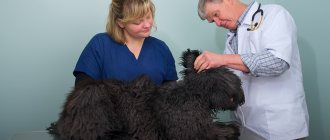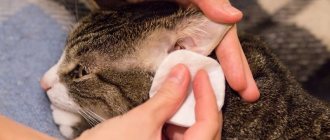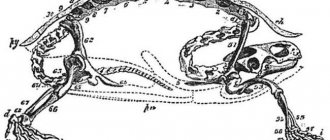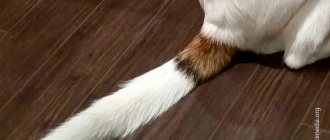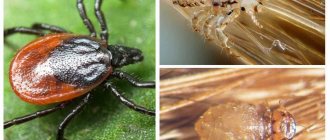There are quite a few reasons why a dog scratches its ears with its paws, and at the same time they are all different.
Most often, a dog scratches its ears when it has ear diseases.
The fact that your pet’s ears hurt is not difficult to notice by the behavior of your dog: he often begins to scratch his ears with his paws, shake his ears, and various kinds of discharge appear from his ears. Moreover, an unpleasant odor emanates from these secretions.
Ear disease is most common in those breeds of dogs that have long floppy ears - setters, dachshunds, Afghan hounds, spaniels, beagles, etc. And this is due to the fact that the ears of such dogs often lie on the floor and are poorly ventilated.
Causes of ear disease in dogs:
- Ear mites.
- Inflammation of the middle ear.
- Inflammation of the outer ear, including otitis externa.
- Allergic and skin diseases.
- Trauma in the ear area, incl. ear hematoma.
- Foreign bodies that enter the dog's ear during a walk (dry grass, plant seeds, etc.) initially lead to irritation of the delicate skin of the ear and the development of inflammation. As a result of bacteria, viruses, fungi and yeast entering the ear canal.
- Disease of the endocrine glands (hypothyroidism).
- Various types of hereditary and immune diseases, as well as cancer.
What causes a dog to scratch its ears?
The dog shakes its head and ears, how to treat it and, most importantly, how to establish the true cause of such an unpleasant phenomenon. There can be many reasons, and they are all quite different. Ear pain is caused by swelling and accompanying inflammation in the shell. Next, purulent discharge and a layer of secondary infections appear. Let's look at possible options with something like this.
Otitis
This is an ear infection. All breeds of dogs are affected, but dogs with drooping ears pressed to the head have a predisposition. Otitis is also promoted by contaminated ears, in which “wax” begins to rot and pathological flora develops. According to its essence and location, otitis media can be external (the safest and easiest to treat, located up to the eardrum), moderate (the most common) and internal (the most severe form). There can be very many causes of inflammation and, therefore, there can be many variants of otitis media too. They, in turn, are distinguished by the alternative factor that caused the inflammatory process, and, consequently, otitis media itself. What is typical is that the dog constantly scratches its ear, regardless of the irritation factor. Thus, there are the following types of otitis: infectious (bacterial, fungal), allergic, traumatic, parasitic.
Infectious otitis media can develop, for example, due to a fungal infection or any other pathogenic microbes that cause inflammation and a purulent reaction in the body. A specific pathogen is identified using bacterial culture and preferably with sensitivity to drugs. But by themselves they may not cause harm, and therefore a stress factor is needed that will reduce the body’s resistance. This can happen with a cold in the ear, water ingress, diaper rash in the auricle, or injury. Microorganisms that live on the fur of a healthy dog without causing harm turn into the cause of otitis media. The course of the disease is complicated by the layering of secondary infections. Characteristic for such otitis:
- squelching in the ear,
- sputum,
- increase in local temperature,
- specific unpleasant odor.
Cleaning your ears with peroxide is very important. The use of medicinal dyes - blue or fucorcin - gives a consistently positive effect, acting on both fungi and bacteria. Swelling is relieved using novocaine blockade, topical hydrocortisone, and dexamethasone.
Important! Ointments or drops are applied only to a clean ear!
Depending on the pathogen, Fluconazole, antibiotics, or a combination of both are used.
Purified birch tar without additives (turpentine, oleoresin, etc.) perfectly helps with otitis media of this nature. When the tar layer dries out, it falls out of the ear when kneaded, along with the products that appear due to the development of the disease.
Otodectosis
Parasitic otitis media is most often caused by ear mites. For example, otodectosis appears due to mites that parasitize the ear. Causes severe pain, and the dog scratches its ears until it bleeds. Often the pet tilts its head towards the affected ear. This is how a subcutaneous mite can manifest itself. And it happens that after immunosuppressive conditions, demodicosis develops in the ears on its own, which does not pose a problem and lives on the body of all dogs. With otodectosis, in addition to inflammation and swelling, black discharge appears in the ear. It is important to clean them well, since medications will not be able to effectively penetrate through them and have an effect. Ear cleaning is done with cotton swabs or cotton wool wound on a stick of a suitable size. Cotton wool is moistened with a 3% peroxide solution. Novocaine blockades around the auricle have worked well to relieve inflammation and swelling. Mix 2-5% percent novocaine with an antibiotic (for example, Bicilin 3). It is important to beware of allergies to novocaine. The following drugs are used to combat ticks:
- Aurikan,
- Leopard,
- Dekta,
- Otibiovin,
- Otovedin, etc.
Birch tar, purified without additives, perfectly helps with tick-borne otitis and fights accumulated infections. Destroying mites and bacteria, it simultaneously relieves swelling and inflammation. When it dries, it heals wounds. When dry, it is easily removed from the auricle.
Allergy
Allergic otitis media is swelling of the ear as a response of the body to a specific allergen. Everything here is strictly individual and there is no stable trend observed among pets. The basis of treatment is identifying the allergen. This test will best be carried out by a veterinary laboratory. The allergen is excluded, symptomatic treatment is carried out aimed at relieving swelling and its consequences. Apply:
- Hydrocortisone,
- Dexamethasone,
- Diphenhydramine.
If the dog scratches its ears very much, then anesthesia is performed with novocaine (beware of allergies!).
Trauma or foreign object in the ear
An injury, even a minor one, can lead to big problems, especially in breeds with floppy ears. Simple hyperemia at the site of a bruise or bite easily develops into inflammation and otitis media, which does not keep you waiting. Not to mention the serious wounds and complications that accompany them. The dog scratches its inflamed ear, thereby aggravating an already difficult situation. With the development of pathology in the ear (otitis), this process only gets worse.
A foreign body in the ear canal itself causes discomfort, and the dog tries to remove it in the same way - by scratching. If the body is small and harmless, then everything will go smoothly. But anything can get into a dog’s ear, especially a puppy’s. A puppy scratches its ear and a sharp foreign object itself injures the ear and the consequences are known. Until the cause of concern is identified, it is too early to talk about treating otitis media. When eliminated, treatment is prescribed symptomatically, taking into account possible layered infection.
Lice eaters, fleas and other parasites
All of the above parasites harm the host’s body and lead to damage to the pet’s skin and hair. The presence of parasites in itself weakens the pet, and if their bites are located in the ears, otitis will occur very quickly. The more parasites there are on an animal’s body, the higher the likelihood of developing pathology in the ears due to their activity. The bites themselves are painful, and the dog will instinctively scratch and even injure the ear. For example, lice readily locate on the head and neck (under the collar), and the ears are very close. It's warm there and there is somewhere to hide from the back paw in case of danger. Good antiparasitic drops solve this problem. In this case, otitis media is treated according to the general scheme, including layered problems.
Information for cat owners.
The cause of severe itching and external otitis in cats in 50% of cases is otodectosis. To treat otodectosis in cats, you can use antiparasitic ear drops , drops on the withers, or injections of an antiparasitic drug.
Antiparasitic ear drops must be instilled at least 3 times with an interval of 5-7 days (this is due to the development cycle of the tick). For example, your veterinarian may prescribe Bars Forte ear drops for cats . This drug has the widest spectrum of action against pathogens; has a therapeutic effect for otitis caused by both microbes and fungi; has an anti-inflammatory effect. According to reviews from owners , Bars ear drops for cats are indeed very effective, affordable and easy to use. However, remember, if you drop drops into dirty ears, the drug will not be able to penetrate deep into the ear canal, and accordingly, the drops may not be able to start working. This is another reason why it is better to do this procedure at a veterinary clinic for the first time. Remember that only with the correct use of Bars ear drops for cats or any other ear drops, the treatment will be effective and will not cause discomfort in the animal.
Drops on the withers have an excellent therapeutic effect. This is especially useful for animals that react negatively to ear cleaning and drops. However, these drugs are expensive.
If the lesions are severe, injections of an antiparasitic drug (ivermectin) may be required. The drug is administered subcutaneously 3 times with an interval of 10 days. This is a 100% way to get rid of ear mites. The disadvantage of this method of treatment is pain when administering the drug, and the need to visit the clinic for injections.
Attention! Otodectosis is very contagious in cats , so it must be diagnosed and treated only by specialists at a veterinary clinic, and not from photos on the Internet. The sooner you start professional treatment, the faster your pet will recover!
Symptoms to watch out for
The first sign of otitis is the dog's obsessive scratching of the sore ear and constant shaking of the ears. In especially severe cases, the ears are torn to the point of bleeding, and dried wounds with traces of scratches are often observed. After seeing this phenomenon, it is important to examine your dog's ear. Looking inside, you will see a characteristic picture there - there is severe inflammation, a local increase in temperature, and there are various discharges. The color and smell of the discharge depend on the type of otitis media. With tick-borne otitis there is a black discharge, with bacterial otitis it is white-yellow, etc. A characteristic feature is the presence of severe itching, which really bothers the dog. With infectious otitis media, a squelching sensation is felt in the ears when palpated.
Allergic otitis media
More often it develops due to an allergy to food or hormonal imbalance. The disease is accompanied by severe swelling, redness of the skin on the inner surface of the auricle, serous discharge and an abundance of wax.
The allergy is accompanied by a fungal infection (Malassezia), additionally creating problems such as severe itching, scratching, and damage to the dermis. The nature of the discharge changes to purulent.
Treatment – elimination of the cause of the allergy (change of food or treatment of endocrine diseases). Antipruritic drugs are prescribed - Sofradex, Triderm, Otodepine.
How to identify the cause of anxiety
The first thing to do is to examine the ear for the presence of a foreign body. It is important to clean the ear of discharge and possible pus. With otitis media of a bacterial nature, the ear squishes. Parasitic otitis media is characterized by black discharge. It is important to take a sample for analysis. The scraping can reveal parasites (mites) under a microscope. A smear is also taken for bacterial culture, which is sent to the laboratory. There, a colony of the pathogen is grown on a special medium, differentiated, and tested for sensitivity to antibiotics. Lice, lice and various other parasites are detected visually.
Tumors (neoplasms) of various origins
In the area of the outer (less often inner) ear in dogs older than 5 years, as well as in those who have had otitis media, otodectosis, etc., without receiving normal treatment, tumors may occur. Visually, minor inflammation, looseness, folding of the skin or obvious pathological growths are visible. In advanced cases or with a malignant course of the disease, there is an unpleasant odor from the ears and discharge.
Treatment is based on the results of the examination. If the tumor is external, easily accessible and small, surgery is warranted. In case of multiple processes, tissue changes, or a critical age of the dog, the veterinarian may refuse removal and prescribe symptomatic (local) treatment.
Relieving itching at home
With otitis media of various etiologies, the dog’s ears hurt, the dog shakes its head, treatment generally comes down to cleaning the ear cavity, relieving itching and inflammation, and identifying pathogens. But let's focus on the itching.
To relieve itching, clean your ears well. Hydrogen peroxide and cotton wool, ear sticks will come in handy. Removing crusts, pus, and other secretions will allow fresh air to enter the affected skin of the ear. The wounds will begin to dry out, the local temperature will drop, and the inflammation will subside. This is how we relieve primarily itching and partially pain. We treat wounds outside the ear with wound healing agents. Hydrocortisone ointment can be applied to a clean, dry ear. Novocaine blockade around the auricle is very helpful in relieving itching.
If you don’t have such products at hand, you can use insecticidal-acaricidal powder, which will dry out the ear and relieve inflammation. You can use birch tar without additives (purified). It should be spread a little at a time. When it dries, it relieves itching, inflammation, and destroys fungi, bacteria, and parasites. The main thing is to check whether the dog is allergic to tar.
Important! Without examining a doctor to ensure the integrity of the eardrum, beware of deep penetration into the affected ear!
Prevention
Prevention will help protect your pet from most of the possible problems and relieve the unpleasant sensation that causes it to itch non-stop. In order to keep your ears healthy, you need to monitor them practically every day, follow a few simple rules and periodically carry out procedures:
- When making contact, make sure that it does not get inside. This is especially important if the dog has access to natural or just street bodies of water. Most often, long-eared dogs suffer from the problem of flooded and subsequently stagnant water. Be sure to check them after bathing and remove excess moisture with a dry cotton swab.
Carry out regular cleanings every 7-10 days. Use a cotton swab gently moistened with special drops to remove all contaminants, while inspecting the skin for damage or irritation. Do not clean too often, this will disrupt the microflora and lead to increased wax production and additional irritation.
- Get rid of excess hair . At best, it will tickle the skin, and it will begin to itch. At worst, an excess of hair will lead to air stagnation and constant irritation, which over time can trigger the development of otitis media.
- Avoid contact with homeless or simply unfamiliar strange animals. Even a decent-looking animal may well turn out to be a carrier of infection or parasites.
- Regularly treat your dog with antiparasitic medications.
- Don't forget to get your veterinarian checked and vaccinated on time.
- Monitor your pet's immune system and use vitamin supplements as needed.
- Protect the animal from hypothermia.
First aid for redness
If a tick is found, it is removed independently or in a clinic . This is not a very complicated procedure, especially since tools for effectively capturing attached parasites have appeared on the market.
Important! If a foreign body is lodged in the ear canal that you are unable to remove (due to the depth of penetration), do not risk it - take the dog to the hospital. Inept actions will only aggravate the situation - you will only push the foreign object even further.
To stop allergic manifestations, give your pet (based on its weight and age) any antihistamine. This will relieve ear redness and itching, but will not get rid of allergies. If you don’t want to test your animal for allergens, try to find the irritant yourself.
There is a special technique for this, with a step-by-step elimination of foods/types of food: it will take more than one day or even a week, but you will understand what food causes an allergic response.
If you focus on industrial food, try switching the animal to a new, dietary line of products or switching to a natural menu. In the latter case, the products are not mixed, but introduced gradually, observing the dog’s reaction.
If you were unable to detect the allergen, and your pet’s ears are still red and itchy, you will have to visit Aibolit.
Return to content
Eczema
The cause of irritation in the form of eczema occurs due to pollen entering the ear. Water, chemicals, sulfur accumulation. Sometimes the cause is parasitic insect bites.
Symptoms:
— Itching begins in the ear, redness appears.
— The dog shakes its head and tries to scratch its ears. As a result of scratching, the eczema blisters burst and become infected. Secondary inflammation of the skin may develop against the background of eczema.
Treatment:
1. Instillation of drugs Ottinum, Ottipax into the ears.
2. Drops can be supplemented with painkillers (Diphenhydramine, Analgin).
3. The skin inside the ear is wiped with disinfectants - Rivanol, Hydrogen Peroxide, Boric Acid.
4. If there is severe irritation or swelling, use Geocorton and Hydrocortisone ointments.
============================================================================================================================================================================================
